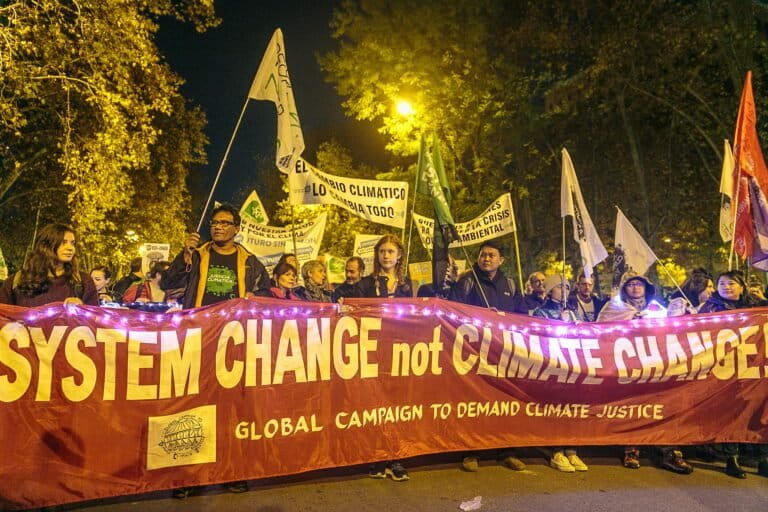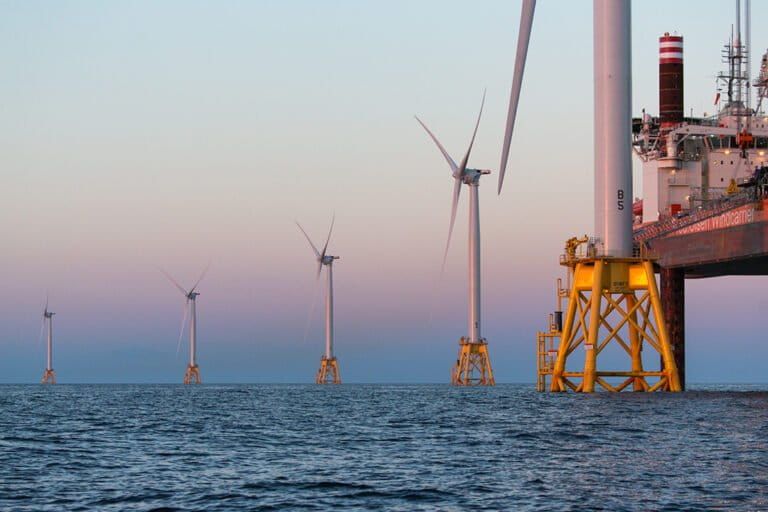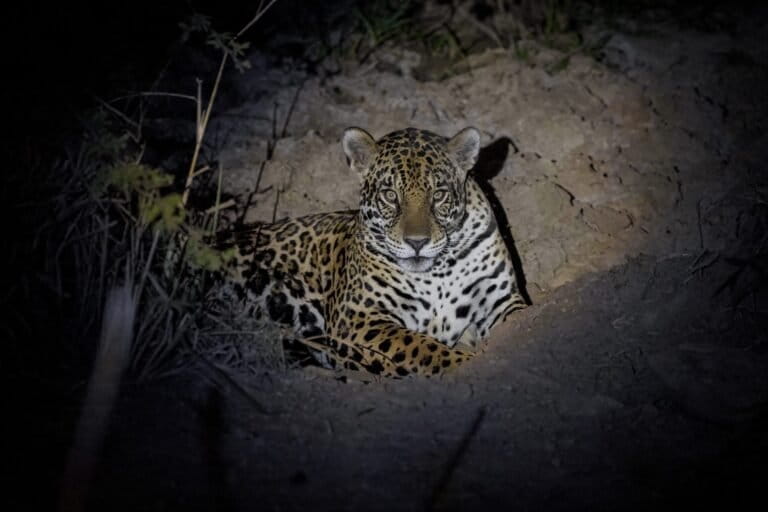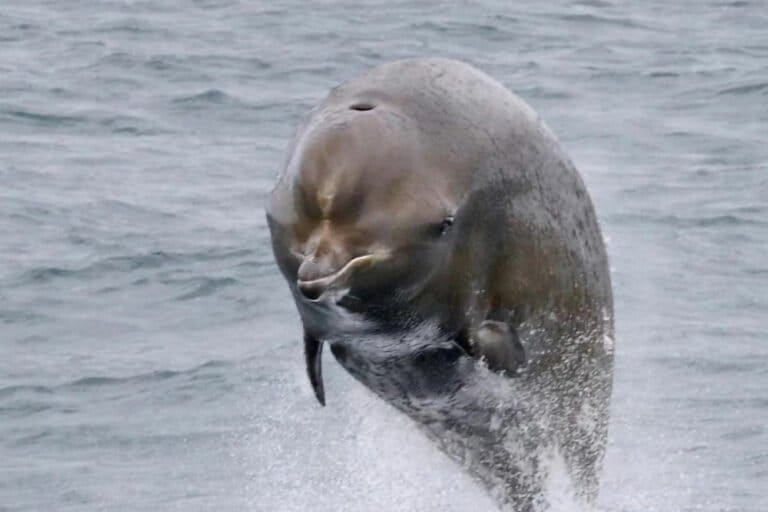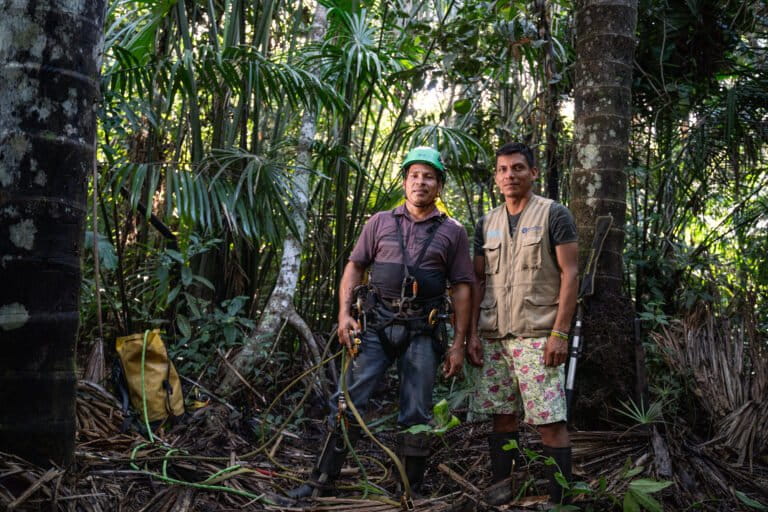- On Cambodia’s coast, fish catches have dropped precipitously in recent years, and so have small-scale fishers’ incomes.
- Small-scale fishers say commercial trawlers have been illegally entering their fishing grounds, scraping the sea clean of life and, with it, their community’s ability to survive.
- Although fishers often blame foreign vessels, satellite data show Cambodian-, Thai- and Vietnamese-flagged trawlers making frequent illegal incursions into Cambodia’s protected waters, community fisheries or shallow inshore waters legally reserved for small-scale fishers.
- This is the first part of a Mongabay series about challenges faced by Cambodia’s small-scale fishers along the coast.
This is the first part of a Mongabay series about challenges faced by Cambodia’s small-scale fishers along the coast. Read Part Two and Part Three.
KOH KONG, Cambodia — At around 10:45 p.m. on a Friday in March, the order came to turn out the lights about 3 kilometers, or a mile and a half, from shore. Chhuan, the speedboat’s driver, who gave only his first name, killed the engine, and in the pitch black, rolling on the waves, the fishing village of Chroy Svay was barely visible. The crew huddled around a digital map, checking that they wouldn’t run into fishing nets laid by their fellow fishers that morning.
“What did you say? It’s a trawler, right?” Sedh Phoeun, another local fisher on board, was frantically asking his brother over the phone whether the steady hum of the trawlers’ engines was still audible back on shore. From the speedboat, Phoeun had temporarily lost both sight and sound of them.
“I see,” Phoeun said into the phone before relaying directions to Chhuan: Two trawlers were heading west. Perhaps they’d heard the sound of the speedboat and were trying to flee these fishing grounds.

Phoeun, Chhuan and the other men on board the speedboat aren’t police or navy. They’re members of the Chroy Svay community fishery (CFi), a group of local small-scale fishers, and they’re responsible for patrolling the nearly 13,500-hectare (33,300-acre) body of water from which they pluck their livelihoods.
But while these waters are meant to be managed sustainably by the CFi to ensure its members can fish to feed their families, commercial trawlers have been illegally entering the CFi’s fishing grounds, scraping the sea clean of life and, with it, the community’s ability to survive.
Skimming atop the waves, following the now-audible thrumming of the trawlers, Chhuan pointed as the lights aboard one trawler’s deck flicked on. A flurry of activity was visible as the speedboat drew nearer, having traveled some 6 km (3.7 miles) but now only 1.3 km (0.8 miles) from shore in Cambodia’s southwestern province of Koh Kong.
One trawler had already pulled up its net and the crew were bundling their catch into the hold. The other trawler, still with its lights off, wheeled around to face Chhuan’s speedboat as it approached.

Suddenly, headtorches aboard the trawlers sent powerful beams of light out of the gloom, illuminating the faces of the men on board the speedboat. Ordinarily, a speedboat would mean either the Royal Cambodian Navy or the Fisheries Administration, hence the trawlers’ earlier apparent decision to run. But the CFi has no authority to arrest the trawlers or seize their illicit catch, and now they were taking a more aggressive stance.
According to bathymetry data published by the General Bathymetric Chart of the Oceans (GEBCO), the trawlers were operating in waters less than 10 meters (33 feet) deep, in violation of Cambodian law, which prohibits trawling in the near-shore exclusion zone that comprises depths of 20 m (66 ft) or less and is reserved for small-scale fishers like CFi members.
The two boats, Phoeun said, could have been operating as pair trawlers, which is also illegal in Cambodian waters: Two vessels hoist a dragnet, sometimes kilometers long, between them and scoop up everything in its path. But in the pitch-black chaos it was difficult to see what was happening on the water — or below it.
The unlit trawler made several moves to ram the speedboat, forcing Chhuan to perform countermaneuvers, wary that there may still be an unseen dragnet that could catch his propeller and leave the speedboat stranded.
After almost an hour, with no means of communicating between the trawlers and the speedboats, the trawlers’ crews appeared to hedge their bets and left. It was a victory, albeit a small one, in a fight for survival that small-scale fishers have almost lost to illegal trawling.
Plenty less fish in the sea
“If the trawlers continue to illegally catch fish, all kinds of life will be gone as it will all be caught by the trawlers’ nets,” Phoeun said the next morning on his fishing boat, a motorized long-tail with a small tarpaulin roof covering a makeshift bench and the rusty engine. “They drag their nets across the bottom and move kilometers throughout the night.”
Not only are the trawlers stealing the fish by illegally entering prohibited waters, but their nighttime raids often destroy the nets left out overnight by small-scale fishers like Phoeun.
“I leave these nets the whole night,” said Phoeun, explaining that he goes out early in the morning to reel in his catch. “The trawlers come and damage my fishing nets; they drag through them with their fishing gear.”

The damage is rarely compensated for by the trawlers’ crews, who Phoeun said have pointed guns at him and threatened to sink his boat on the occasions when he’s been able to catch them.
The combined costs of having to repair nets while catching fewer fish from their traditional fishing grounds have left Phoeun and many others in Chroy Svay submerged in debt. He pays more to repair his nets than they earn him in return.
Despite the fact that he lays his nets just 1.5 km (0.9 mi) from shore, Phoeun said trawlers routinely come in to fish in the same waters, pilfering everything between the surface and the seabed.
“The law says that trawlers should catch fish in waters deeper than 20 meters, but these waters are 3-4 meters [10-13 ft] deep,” he said. “Look at this catch from this morning. I’ve caught less than 1 kilogram [2 pounds]. How can I feed my family? How can my kids go to school?”

At 5 a.m. each day, Phoeun takes his boat out through the mangrove forests that run along the creeks of Chroy Svay until he reaches the sea. There, he pulls up the nets he laid the previous day to collect his catch. By around midday, he’s back home, examining the catch.
“I started fishing when I was 11 to 12 years old, more than 30 years ago,” he said. “I’ve seen about an 80% reduction in my catches.”
The morning’s work, and that of the afternoon before, netted Phoeun an estimated 50,000 riel, roughly $12.50. But of that, he spent around $2.50 on diesel and supplies. After some lunch, he set back out to lay his nets for the coming night, hoping they would be spared from the trawlers.

‘Race to catch the last fish’
Like Phoeun, many small-scale fishers along Cambodia’s coast are suffering. Research by the Asian Development Bank (ADB) shows that 67% of Cambodia’s coastal fishing households reported a rapid recent decline in fishing income, with an average reduction of 50% from 2019 to 2022. Coastal fishing communities had poverty levels of 36% compared with the national average of 18%.
Catches along the coast dropped at lightning speed, too: by as much as 60% between 2017 and 2022, according to the ADB. Overfishing was projected to result in a further decline of 30% by 2030. The bank warned that unsustainable fishing practices, inadequate management and monitoring, as well as rapidly degrading habitats for marine life are leading to “a race [to] catch the last fish.”
The Fisheries Administration’s own data, seen by Mongabay despite not being publicly available, showed that of the more than 3,300 Cambodian fishing crew members and vessel owners interviewed anonymously across the coastal provinces of Kampot, Kep, Koh Kong and Preah Sihanouk between May 2022 and December 2023, roughly 40% worked on or owned trawlers.
When asked where they fish, 93% of the trawler workers and owners reported that they either illegally trawled inshore — in waters shallower than 20 m — or fished both in- and offshore.

The severity of Cambodia’s plummeting marine fish stocks and illegal fishing problem is matched only by its sensitivity. Nobody from the Fisheries Administration or the Ministry of Agriculture, Forestry and Fisheries would speak on the record about the problem. Nor would Fauna & Flora, the leading NGO working on coastal conservation in Cambodia. Similarly, the ADB, the Food and Agriculture Organization of the United Nations and the European Union delegation to Cambodia, which operate or directly fund programs to address illegal fishing off the coast, all declined to comment. The regional office of the IUCN, the global wildlife conservation authority, which is based in Bangkok, said nobody was available to discuss the matter, while local NGOs and academics contacted wouldn’t speak publicly or didn’t respond to requests for comment.
Globally, calls for bans on bottom trawling are growing, reflecting an increased understanding of the ecological problems it can cause. It results in a huge volume of bycatch: nontarget species caught in trawlers’ nets that are often thrown back dead. Compounding this, trawlers often destroy the habitats necessary for the replenishment of sea life. The damage done to the seabed also releases stored carbon, although the extent of this problem remains disputed.
In Cambodia, where trawling nevertheless remains a routine method of fishing, bycatch often includes globally endangered green (Chelonia mydas) and critically endangered hawksbill turtles (Eretmochelys imbricata), particularly when trawlers operate in seagrass meadows where turtles typically forage.
Koh Kong and Preah Sihanouk, the two largest coastal provinces in Cambodia, together accounted for more than 90% of the country’s total marine fisheries catch in September 2023 — with 72% of the nearly $7 million catch being landed by trawlers, according to the Fisheries Administration’s data.

At ports in the city of Sihanoukville and on the island of Koh Rong, both in Preah Sihanouk province, Mongabay witnessed a wide array of species being unloaded from trawlers, including what experts identified as the critically endangered bottlenose wedgefish (Rhynchobatus australiae).
During March 2024, Mongabay spoke with more than 30 small-scale fishers, CFi members, trawler workers and owners across Koh Kong and Preah Sihanouk province. All of them told us that catches were declining. Even those employed on trawlers acknowledged their work was likely driving that decline.
“As a worker working for a daily wage, we don’t think about the environmental impact, that’s the obligation of the owner,” said one fisher working on a trawler moored in the port of Sihanoukville, Cambodia’s largest coastal city. “These days we don’t catch enough, and if we don’t catch enough, the boat will not go fishing. When the boat is not out, we don’t get paid.”

Unseen, untracked and unchecked trawling
Across Kampong Som Bay, directly opposite Chroy Svay, fishing communities in Thma Sa commune echoed Phoeun’s exasperation with trawlers.
“Fishermen used to catch fish, but since the coming of the pulling boats [trawlers], people have changed their livelihoods,” said Sreylin, a woman whose family relies on fishing and requested anonymity as she feared retribution from local authorities.
Sitting outside her wooden home along the concrete jetty of Thma Sa’s biggest port, repairing fishing nets while she waited for her husband to return from the sea, Sreylin told reporters that trawlers came from Sihanoukville and the smaller port town of Stung Haev. These trawlers, Sreylin said, have so depleted the fish stocks in the waters around Thma Sa that the communities switched to catching crabs and lobsters. But even these species were vanishing in the nets of the trawlers.
“Seven to eight years ago we caught so many crabs, now it’s uncertain,” she said. “Life is really poor now. Some days we make no money at all and we can’t even pay for the gasoline and diesel we used.
“It’s a mix of Vietnamese and Cambodian boats,” she added. “It’s mostly Vietnamese fishermen.”
Sreylin’s observations are, to an extent, supported by satellite data provided by the online vessel-tracking platform Global Fishing Watch that show Cambodian-, Thai- and Vietnamese-flagged trawlers making frequent illegal incursions into Cambodia’s protected waters, community fisheries or other waters of 20 m depth or shallower.

But this information hinges on the installation of either an automatic identification system (AIS) or a vessel monitoring system (VMS), both of which provide GPS data enabling ships to be tracked. AIS is typically installed to help crews avoid collisions with other vessels and produces publicly available satellite data. VMS, on the other hand, allows for the tracking of vessels in a more granular way, but the data remain with governments or regulator bodies; only 10 countries have made their VMS data public.
Cambodia, with barely 100 vessels using VMS, has not made this data public, and Global Fishing Watch data show only 58 trawlers have been detected via AIS data since 2012. This means that the vast majority of Cambodia’s fishing fleet remains opaque, untraceable and unaccountable by remote monitoring. The most recent data, from 2018, show a fleet of 1,569 registered trawlers, but more recent data haven’t been published by the Fisheries Administration.
By contrast, Global Fishing Watch found AIS signals from 354 trawlers flagged to Thailand — around 10% of the country’s estimated 3,370 trawlers — and from more than 22,000 flagged to Vietnam.
A 2024 paper published in Nature used satellite imagery to find otherwise undetected vessels; it found that 72-76% of the world’s industrial fishing fleet can’t be publicly tracked. Much of it operates in Southeast Asia, South Asia and Africa.
“Satellite monitoring in general is a tool that is really good at seeing one type of criminality, like foreign industrial incursions into Cambodian waters,” said Ian Urbina, executive editor of the Outlaw Ocean Project, a journalism nonprofit that reports on crimes at sea. “You’re going to see that as a big problem, partially because you’re looking through a certain lens; what you’re not going to see is the internal criminality.”

Cambodian vessels, being so hard to track, provide disproportionately less GPS data than Thai or Vietnamese vessels, meaning they appear in satellite data to be committing fewer fisheries crimes. And there have been repeated claims, particularly among pro-government media, that illegal, unreported and unregulated fishing in Cambodian waters is largely down to foreign fishers.
Almost all the fishers Mongabay spoke to said they felt it was mostly Thai or Vietnamese trawlers decimating Cambodian marine life. But many also conceded that their compatriots were likely bribing their way to fishing in prohibited waters. Despite the nationalist assertions that fishing crimes were the preserve of foreign vessels, almost all sources identified the Cambodian ports of Stung Haev and Sihanoukville as the ports of origin for the trawlers plundering the sea.
“The internal, smaller, probably more prevalent, and in some ways, maybe even more consequential, but politically sensitive, form of illegality is harder to quantify,” Urbina said. “The industrial big guys are foreign and it fits inside an anticolonialist narrative that makes total sense and it’s an easy story to sell for the Western media, but writing about Cambodian-on-Cambodian crime, it’s a tougher sell and it’s hard to measure.”

Enforcement is weak, corruption is strong
Out of the 30 or so sources who spoke to Mongabay across Koh Kong and Preah Sihanouk provinces, more than one-third said corruption was fueling the wholesale destruction of marine life, although many told reporters they were too afraid to discuss the topic.
One of the few who wasn’t was Poch Chheak, who’s been in the fisheries business for more than 20 years. Mongabay spoke to Chheak as his trawler was being unloaded at the port of Sihanoukville, Chheak intermittently scribbling down notes as tray after tray of a wide array of species was brought onshore.
The trawler and its fishing gear cost, altogether, around $200,000, Chheak said. But the vessel, which towered over many of the others moored at the port, guzzles diesel, leaving Chheak with a profit margin of between 10% and 20%, depending on the success of his crew.
The crew use a GPS device, Chheak said, but predominantly for avoiding collisions. His trawler avoids fishing in conservation areas and other prohibited waters based on his 20 years of experience, he said, although he did not have the maps of these places.
“The Fishery Administration tells us where we can’t trawl,” he said. “They’ll stop us from trawling.”
However, this relies on the Fisheries Administration patrolling continuously and often throughout the night, when trawlers operate — something most sources Mongabay spoke to suggested wasn’t happening. Many sea creatures, such as shrimp, are more active at night, which has led to more trawling at night, although there are other advantages to operating under the cover of darkness.
When asked whether his trawler could be operating in protected or prohibited waters without any intervention from the Fisheries Administration, Chheak confirmed that his vessel would continue to trawl there, as nobody was telling them not to.
“People who trawl inside those areas, they pay bribes [to the Fisheries Administration],” he said. But he denied having paid a bribe himself — only tax to the state.

Chheak’s trawler bore no name, but did appear to be registered to the port of Sihanoukville. However, no publicly available registry exists to check. As of September 2023, pro-government media reported that just 65 of Sihanoukville’s 2,523 boats were registered. This figure reportedly rose to more than 800 across the whole province by December 2023. However, while updated figures seemingly exist in government records, they aren’t publicly available, and Fisheries Administration officials didn’t respond to Mongabay’s repeated requests for comment on the matter.
“To fish illegally requires a lot of money … tens of thousands of dollars,” said Phoeun back in Chroy Svay village.
He pointed the finger at the trawlers coming in from Sihanoukville and Stung Haev — a common perception among fishers across Cambodia’s southwest coast.
“The illegal fishermen become rich very fast, and we, the legal fishermen, are still poor,” said Noem Saran, another fisher in Chroy Svay.
“I think [they are paying bribes], but even if they have paid to fish, they do not have the right to catch the fish at 2-3 meters [6-10 ft] depth in our shallow waters,” Saran said, comparing the trawlers to big cars paying traffic police after breaking the law. “We don’t have the ability to illegally catch fish because [a trawler is too expensive, and] if it gets seized, we don’t have the network to get it back.”

The Fisheries Administration’s limited means of enforcement, coupled with corruption and the historical profitability of trawling, has allowed the problem to fester for years, with minimal intervention from the government.
“I think in fishing, corruption is key,” Urbina said. “If you’re going to engage in illegality of any type, then the only way you can get away with it is either you’re doing it in a blind spot of governance and law enforcement, so you don’t really need to pay anyone off because no one’s looking. Or you’re doing it in plain sight, but you paid the right people off to look the other way.”
Meanwhile, for Phoeun and other fishers fighting for their survival off the Cambodian coast, the need for government intervention in the sprawling problem of illegal fishing is a matter of life and death.
“Many fishermen die after confronting the trawlers,” said Phoeun, citing the long history of trawlers ramming small-scale fishing boats. “We will be very happy if the trawlers are stopped by anyone.”
Banner image: Trawlers docked in the port of Sihanoukville are decimating Cambodia’s waters. Screenshot from ‘Illegal fishing and land grabs push Cambodian coastal communities to the brink’ by Andy Ball / Mongabay.
Citations:
Hiddink, J. G., van de Velde, S. J., McConnaughey, R. A., De Borger, E., Tiano, J., Kaiser, M. J., … Sciberras, M. (2023). Quantifying the carbon benefits of ending bottom trawling. Nature, 617(7960), E1-E2. doi:10.1038/s41586-023-06014-7
Paolo, F. S., Kroodsma, D., Raynor, J., Hochberg, T., Davis, P., Cleary, J., … Halpin, P. (2024). Satellite mapping reveals extensive industrial activity at sea. Nature, 625(7993), 85-91. doi:10.1038/s41586-023-06825-8









